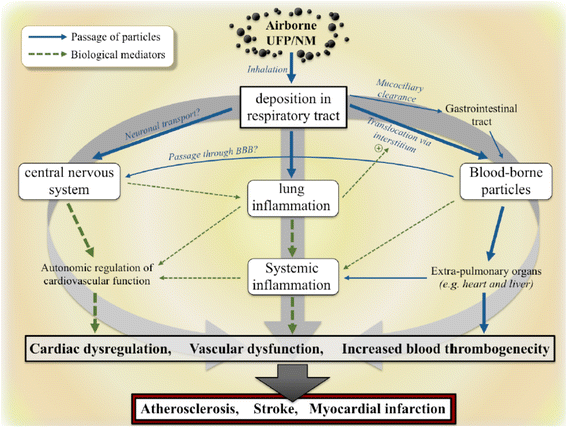The unrecognized occupational relevance of the interaction between engineered nanomaterials and the gastro-intestinal tract: a consensus paper from a multidisciplinary working group
- PMID: 29178961
- PMCID: PMC5702111
- DOI: 10.1186/s12989-017-0226-0
The unrecognized occupational relevance of the interaction between engineered nanomaterials and the gastro-intestinal tract: a consensus paper from a multidisciplinary working group
Abstract
Background: There is a fundamental gap of knowledge on the health effects caused by the interaction of engineered nanomaterials (ENM) with the gastro-intestinal tract (GIT). This is partly due to the incomplete knowledge of the complex physical and chemical transformations that ENM undergo in the GIT, and partly to the widespread belief that GIT health effects of ENM are much less relevant than pulmonary effects. However, recent experimental findings, considering the role of new players in gut physiology (e.g. the microbiota), shed light on several outcomes of the interaction ENM/GIT. Along with this new information, there is growing direct and indirect evidence that not only ingested ENM, but also inhaled ENM may impact on the GIT. This fact, which may have relevant implications in occupational setting, has never been taken into consideration. This review paper summarizes the opinions and findings of a multidisciplinary team of experts, focusing on two main aspects of the issue: 1) ENM interactions within the GIT and their possible consequences, and 2) relevance of gastro-intestinal effects of inhaled ENMs. Under point 1, we analyzed how luminal gut-constituents, including mucus, may influence the adherence of ENM to cell surfaces in a size-dependent manner, and how intestinal permeability may be affected by different physico-chemical characteristics of ENM. Cytotoxic, oxidative, genotoxic and inflammatory effects on different GIT cells, as well as effects on microbiota, are also discussed. Concerning point 2, recent studies highlight the relevance of gastro-intestinal handling of inhaled ENM, showing significant excretion with feces of inhaled ENM and supporting the hypothesis that GIT should be considered an important target of extrapulmonary effects of inhaled ENM.
Conclusions: In spite of recent insights on the relevance of the GIT as a target for toxic effects of nanoparticles, there is still a major gap in knowledge regarding the impact of the direct versus indirect oral exposure. This fact probably applies also to larger particles and dictates careful consideration in workers, who carry the highest risk of exposure to particulate matter.
Keywords: Direct toxicity; Gastrointestinal tract; Indirect toxicity; Ingested nanoparticles; Inhaled nanoparticles; Microbiota; Workers’ exposure.
Conflict of interest statement
Ethics approval and consent to participate
Not applicable.
Consent for publication
Not applicable.
Competing interests
The authors declare that they have no competing interests.
Publisher’s Note
Springer Nature remains neutral with regard to jurisdictional claims in published maps and institutional affiliations.
Figures
References
-
- Chen H, Seiber JN, Hotze M. ACS select on nanotechnology in food and agriculture: a perspective on implications and applications. J Agric Food Chem. 2014;62:1209–1212. - PubMed
-
- Athinarayanan J, Alshatwi AA, Periasamy VS, Al-Warthan AA. Identification of nanoscale ingredients in commercial food products and their induction of mitochondrially mediated cytotoxic effects on human mesenchymal stem cells. J Food Sci. 2015;80:N459–N464. - PubMed
-
- Lim JH, Sisco P, Mudalige TK, Sánchez-Pomales G, Howard PC, Linder SW. Detection and characterization of SiO2 and TiO2 nanostructures in dietary supplements. J Agric Food Chem. 2015;63:3144–3152. - PubMed
-
- Shahabi-Ghahfarrokhi I, Khodaiyan F, Mousavi M, Yousefi H. Preparation of UV-protective kefiran/nano-ZnO nanocomposites: physical and mechanical properties. Int J Biol Macromol. 2015;72:41–46. - PubMed
Publication types
MeSH terms
LinkOut - more resources
Full Text Sources
Other Literature Sources
Medical
Miscellaneous


